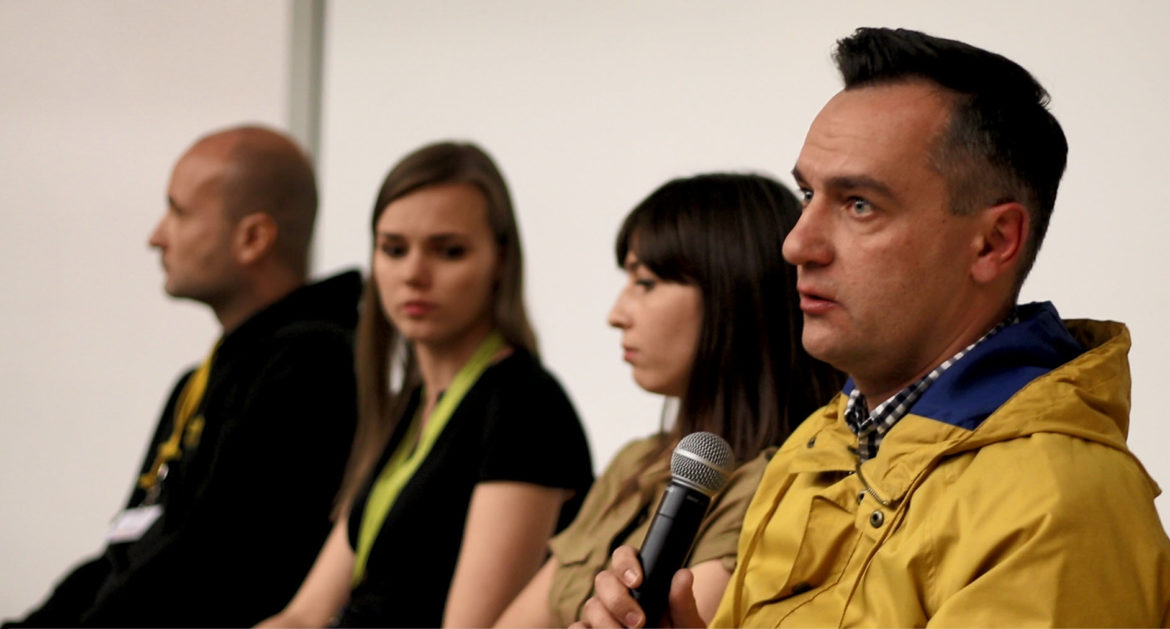বাংলা | Видео на русском| العربية

Talking Tips: Dmytro Gnap (far right) alongside Elena Loginova, Anna Babinets and Vlad Lavrov at GIJC17 in Johannesburg in November 2017. Photo: GIJN
Last weekend in Orlando, Florida, the gripping documentary “Killing Pavel” — which followed the investigation into the murder of reporter Pavel Sheremet — was awarded the IRE Medal, the highest honor Investigative Reporters and Editors can bestow for investigative reporting.
It’s the first time Ukrainian journalists have received the prestigious award, which is often won by outlets like The New York Times (which took it this year for “Harassed” — about the Harvey Weinstein allegations — alongside “Killing Pavel”) or The Washington Post. It’s also the second international award won by the documentary this month; earlier in June the team of reporters received a DIG Festival award in Riccione, Italy.
The film tracks Sheremet’s murder through an investigation led by Slistvo.info and OCCRP journalists Anna Babinets, Elena Loginova, Vlad Lavrov, Dmytro Gnap, Matt Sarnecki, Ilya Magazanin, Sergiu Brega and Timmi Allen (Bellingcat). Key to the team’s investigation was their examination of CCTV footage from more than 50 surveillance cameras, helping them piece together the hours and days leading up to — and just after — the murder.
In GIJN’s YouTube video series, Dmytro Gnap, a top Ukrainian investigative journalist and the founder of nonprofit investigative center Slidstvo.info, gives (in Russian) his top five tips for effectively collecting CCTV footage at the scene of a crime. Here’s a roundup of his best advice for gathering video surveillance footage to help you with your investigation.
1. Collaborate
Working in a group is a lot safer for every journalist involved in the investigation. It’s possible to chase away one journalist but virtually impossible to get rid of several. Journalists are also more effective in a group. You can get more things done and faster.
2. Divide the Area Into Sectors
Take a map of the district where the event happened and divide it into several sectors. Attach one journalist to one sector. These can be between one and three square kilometers. Start looking for CCTV cameras in those sectors and collect the footage as quickly as possible. Footage is generally stored for three to seven days, after which it is deleted, so you need to hurry.
3. Never Try to Predict the Suspect’s Route
Following a gut feeling is a mistake which may cost you a lot of priceless footage. Be patient and methodical and cover your sector. Make a list of your sector’s CCTV cameras and mark your progress as you go. Look out for CCTV cameras everywhere you can, talk to the owners of the cameras and be frank and open about your task. Tell them you are conducting your own investigation into a crime and you need the footage.
4. Don’t Watch the Footage Right Away
Time is of the essence. Analyzing hours of footage may also take hours. Start watching the footage only after you’ve gathered everything you can and it’s impossible to get more. Usually this moment arrives after a month of hard daily work.
5. Have Hard Drives and a Letter From Your Editor Ready
Some CCTV camera owners will be willing to give you the footage right away, so you will need a lot of memory space to download it. Carry several hard drives and memory sticks with you. Others will ask for some sort of document which proves that you have been tasked with conducting this specific investigation. Print out a dozen copies of a letter signed by your editor. Leave the spots which state the names and addresses of the people and places you need to cover blank. You can fill them in on the spot. This will help you work a lot faster.
And don’t miss the “Killing Pavel” documentary:
 Olga Simanovych is GIJN’s Russian editor. She has worked as a screenwriter, media trainer, managing editor and TV news reporter for Vikna-Novyny on STB and has participated in SCOOP‘s international investigations. She is fluent in Ukrainian, Russian, English and Greek.
Olga Simanovych is GIJN’s Russian editor. She has worked as a screenwriter, media trainer, managing editor and TV news reporter for Vikna-Novyny on STB and has participated in SCOOP‘s international investigations. She is fluent in Ukrainian, Russian, English and Greek.
